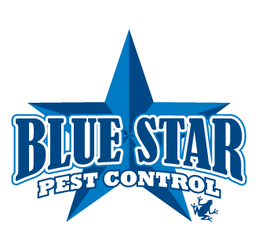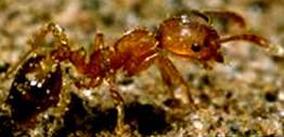Pharaoh Ant
The name for this ant possibly arises from the mistaken tradition that it was one of the plagues of ancient Egypt. However, it is distributed worldwide and is one of the more common and most difficult household ants because it has the ability to survive most conventional treatments and establish colonies throughout a building. More than just the food it consumes or spoils, this ant is considered a serious pest simply due to its ability for "getting into things." The pharaoh ant has become a serious nuisance in hospitals, rest homes, apartment dwellings, hotels, grocery stores, and food establishments. Pharaoh ants are also capable of mechanically transmitting diseases and contaminating sterile materials. Some argue that the Staphylococcus and Psuedomonas infections, occurring from time to time in hospitals, are associated with these ants.
Identification
Pharaoh ants are usually about 1/16 inch long, have antennae, are colored light yellow to reddish-brown with the hind of the abdomen a little darker, and have 12 segments. There is no stinger in the pharaoh ant and the petiole - narrow waist connecting the thorax and abdomen - has two nodes and the thorax has no spines. Eyes are well-developed and the antennal segments end in a distinct club with three progressively longer segments.
Habitat
As mentioned, these ants are able to reside in a variety of locations including: hospitals, rest homes, apartment dwellings, hotels, grocery stores, and food establishments. The nests are often so small that they can be contained in a thimble and even found between sheets of paper, in clothing or laundry, furniture, and foods. Most usually, however, they occur in wall voids, under floors, behind baseboards, in trash containers, under stones, in cement or stone wall voids, in linens, and in light fixtures. These ants prefer dark, warm areas near hot water pipes and heating tapes, in bathrooms, kitchens, intensive care units, operating rooms, etc.
Pharaoh ants are "trail-making" ants and often are found foraging in drains, toilets, washbasins, bedpans, and other unsanitary sites as well as in sealed packs of sterile dressing, intravenous drip systems, on surgical wounds, and food and medical equipment.
Diet
Pharaoh ants have a wide preference in the types of food consumed. They feed on such items as: jellies, honey, shortening, peanut butter, corn syrup, fruit juices, soft drinks, greases, dead insects, baked goods, soft drinks, greases, and even shoe polish. Also, these ants gnaw holes in silk, rayon and rubber goods. In hospitals, foraging ants have been found in surgical wounds, I.V. glucose solutions, sealed packs of sterile dressing, and even in water of flower displays and water pitchers.
Reproduction
Female pharaoh ants can lay 400 or more eggs in her lifetime but mostly lay 10-12 eggs per batch in the early days of egg production and only 4-7 eggs per batch later. About four more days are required to produce sexual female and male forms. The entire life cycle takes about 38 to 45 days depending on temperature and relative humidity. Unlike most ants, they breed continuously throughout the year in heated buildings and mating occurs in the nest. A single queen can produce many hundreds of workers in a few months and mature colonies contain several queens, winged males, sterile females or workers, eggs, larvae, prepupae, and pupae growing to as large as 300,000 or more members.
Periodically a queen, together with a few workers carrying immatures leave the nest and set up a new colony elsewhere leading to quick infestations. This behavior pattern is known as "satelliting," "fractionating" or "budding" where part of the colony migrates to a new location rather than by single females dispersing after a reproductive swarm. Budding may occur due to overcrowding, seasonal changes in the building's central heating and cooling system or application of a repellent pesticide. A major part of these ants’ success is undoubtedly related to budding. Numerous daughter colonies are produced from the mother colony when a queen and a few workers break off and establish a new colony. Even in the absence of a queen, workers can develop a queen from the brood which is transported from the mother country.
If you find these ants, call a professional pest control operator as attempts to eradicate these ants without proper knowledge or equipment will cause the colony to split and multiply at an increased rate.
Identification
Pharaoh ants are usually about 1/16 inch long, have antennae, are colored light yellow to reddish-brown with the hind of the abdomen a little darker, and have 12 segments. There is no stinger in the pharaoh ant and the petiole - narrow waist connecting the thorax and abdomen - has two nodes and the thorax has no spines. Eyes are well-developed and the antennal segments end in a distinct club with three progressively longer segments.
Habitat
As mentioned, these ants are able to reside in a variety of locations including: hospitals, rest homes, apartment dwellings, hotels, grocery stores, and food establishments. The nests are often so small that they can be contained in a thimble and even found between sheets of paper, in clothing or laundry, furniture, and foods. Most usually, however, they occur in wall voids, under floors, behind baseboards, in trash containers, under stones, in cement or stone wall voids, in linens, and in light fixtures. These ants prefer dark, warm areas near hot water pipes and heating tapes, in bathrooms, kitchens, intensive care units, operating rooms, etc.
Pharaoh ants are "trail-making" ants and often are found foraging in drains, toilets, washbasins, bedpans, and other unsanitary sites as well as in sealed packs of sterile dressing, intravenous drip systems, on surgical wounds, and food and medical equipment.
Diet
Pharaoh ants have a wide preference in the types of food consumed. They feed on such items as: jellies, honey, shortening, peanut butter, corn syrup, fruit juices, soft drinks, greases, dead insects, baked goods, soft drinks, greases, and even shoe polish. Also, these ants gnaw holes in silk, rayon and rubber goods. In hospitals, foraging ants have been found in surgical wounds, I.V. glucose solutions, sealed packs of sterile dressing, and even in water of flower displays and water pitchers.
Reproduction
Female pharaoh ants can lay 400 or more eggs in her lifetime but mostly lay 10-12 eggs per batch in the early days of egg production and only 4-7 eggs per batch later. About four more days are required to produce sexual female and male forms. The entire life cycle takes about 38 to 45 days depending on temperature and relative humidity. Unlike most ants, they breed continuously throughout the year in heated buildings and mating occurs in the nest. A single queen can produce many hundreds of workers in a few months and mature colonies contain several queens, winged males, sterile females or workers, eggs, larvae, prepupae, and pupae growing to as large as 300,000 or more members.
Periodically a queen, together with a few workers carrying immatures leave the nest and set up a new colony elsewhere leading to quick infestations. This behavior pattern is known as "satelliting," "fractionating" or "budding" where part of the colony migrates to a new location rather than by single females dispersing after a reproductive swarm. Budding may occur due to overcrowding, seasonal changes in the building's central heating and cooling system or application of a repellent pesticide. A major part of these ants’ success is undoubtedly related to budding. Numerous daughter colonies are produced from the mother colony when a queen and a few workers break off and establish a new colony. Even in the absence of a queen, workers can develop a queen from the brood which is transported from the mother country.
If you find these ants, call a professional pest control operator as attempts to eradicate these ants without proper knowledge or equipment will cause the colony to split and multiply at an increased rate.




